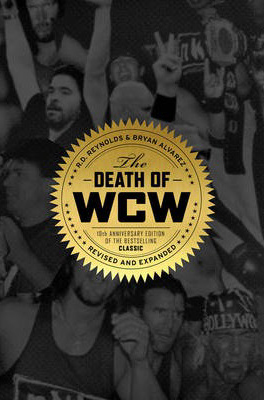 ECW Press, 456 pages, paperback, $19.95
ECW Press, 456 pages, paperback, $19.95
For those who may not realize the long, colorful, and storied history of recent professional wrestling, not too long ago, another wrestling company nearly destroyed Vince McMahon’s WWF (now WWE) by pushing the predictable formula of good and evil into a closer to real entertainment property that ushered in the ubiquitous reality TV era. WCW (World Championship Wrestling) was an Atlanta-based, Ted Turner-owned and operated wrestling outfit that was the number-one wrestling company in the world for most of the late 1990s.
Related Posts
While the WWF lost ratings and key wrestling personalities (who would defect to WCW), WCW thrived with a seemingly endless parade of surprises, well-paced story lines, innovative mid-carders (such as the Mexican wrestling prowess of Rey Mysterio Jr., Eddie Guerrero and Dean Malenko), and a “who’s who” list of A-listing main-eventers.
As Dave Meltzer says in his forward to the new edition, “There are so many lessons to be learned from WCW’s downfall that you would need a book to detail them all. This is that book.”
Each week, millions of wrestling fans tuned in to “Monday Nitro,” jammed themselves into sold-out arenas, and paid a fortune for WCW merchandise. So what the hell happened? Reynolds and Alvarez break down the company’s rise and fall almost week by week. Take the end of 1997 for example here, with a dangling cliffhanger of a chapter ending that would put most tell-alls to shame:
“Starrcade ’97 was, without question, the biggest money-maker WCW had ever produced. 17,500 fans. 534,000 gate. An incredible 1.9 buy rate, meaning nearly $6 million in revenue. And the beginning of the end.”
Presented in part historical narrative, wrestling insider podcast, fan-boy rant, and candid oral history with key players and factoids, the 10th anniversary edition of The Death of WCW is, like the original, a unique specimen examining a bunch of grown men pretending to be other people who beat the living snot out of one another. A group of men who helped (if not singlehandedly) created the late 1990s resurgence of pro wrestling into the pop culture mainstream.
Wrestling scholars needing this course on WCW’s death must treat it like studying masculinity to understand feminism. WCW wouldn’t have existed without the WWF, and the WWE as we know it now as sole ruler of “sports entertainment” wouldn’t exist without the Herculean efforts of WCW during the wars. It brought the best out of Vince McMahon, who had to sink to new depths of innovation to outwit the dirty tricks WCW had used against him such as going on air earlier, revealing the WWF’s storylines and results on air before WWF had even started its Monday night broadcast, and poaching talent in between contracts, to name a few.
When Dennis Rodman began appearing sporadically on WCW programming, Vince McMahon spent a then-fortune to acquire the services of freshly suspended Mike Tyson, “the baddest man on the planet,” and threw him in the middle of Degeneration X (a “heel” group featuring Shawn Michaels and Triple H) and Stone Cold Steve Austin, who was on the threshold of becoming the 1990s’ version of Hulk Hogan.
As this book points out with much comedic flare, these gambles worked occasionally for WCW (who were taking risks with Rodman wrestling on pay-per-view, which they’d do again with Jay Leno as well). The WWF’s use of non-wrestling celebrities in 1998 paid off largely in part because the old guards were now gone from the company (Bret Hart, Randy Savage, Hulk Hogan, etc.), and the product was completely fresh. Adding Tyson for Wrestlemania that year endorsed this change and brought the focus back to the WWF and away from WCW.
The WWF’s sparse use of Tyson was enough to get the company’s fledging superstar Stone Cold Steve Austin popular (“over” in wrestling terms) for good with the fans. It was a moment in the industry in which millions of viewers who had given up on wrestling had a new reason to tune in each week. Suddenly, the brand that had been subordinated for nearly two years by WCW were watching the WWF do it better by learning from WCW’s public performance of mistake booking.
The book reads with a much appreciated sense of transparency. No one factor, character, executive, or circumstance is singled out as culprit in the company’s undoing. Facts are never heavily toyed with, but are used to back up the author’s honest and well thought-out opinions. With terse writing and alluring chapter endings, The Death of WCW is a wrestling fan’s ultimate compendium to countless hours one could spend watching old clips on YouTube or, should you have the $9.99 a month to spare, the WWE Network.
While WWE’s present-day embargo may last for as long as wrestling itself lasts, this book is a faithful reminder of WCW’s legendary rise and all the humor in its irreversible decline.